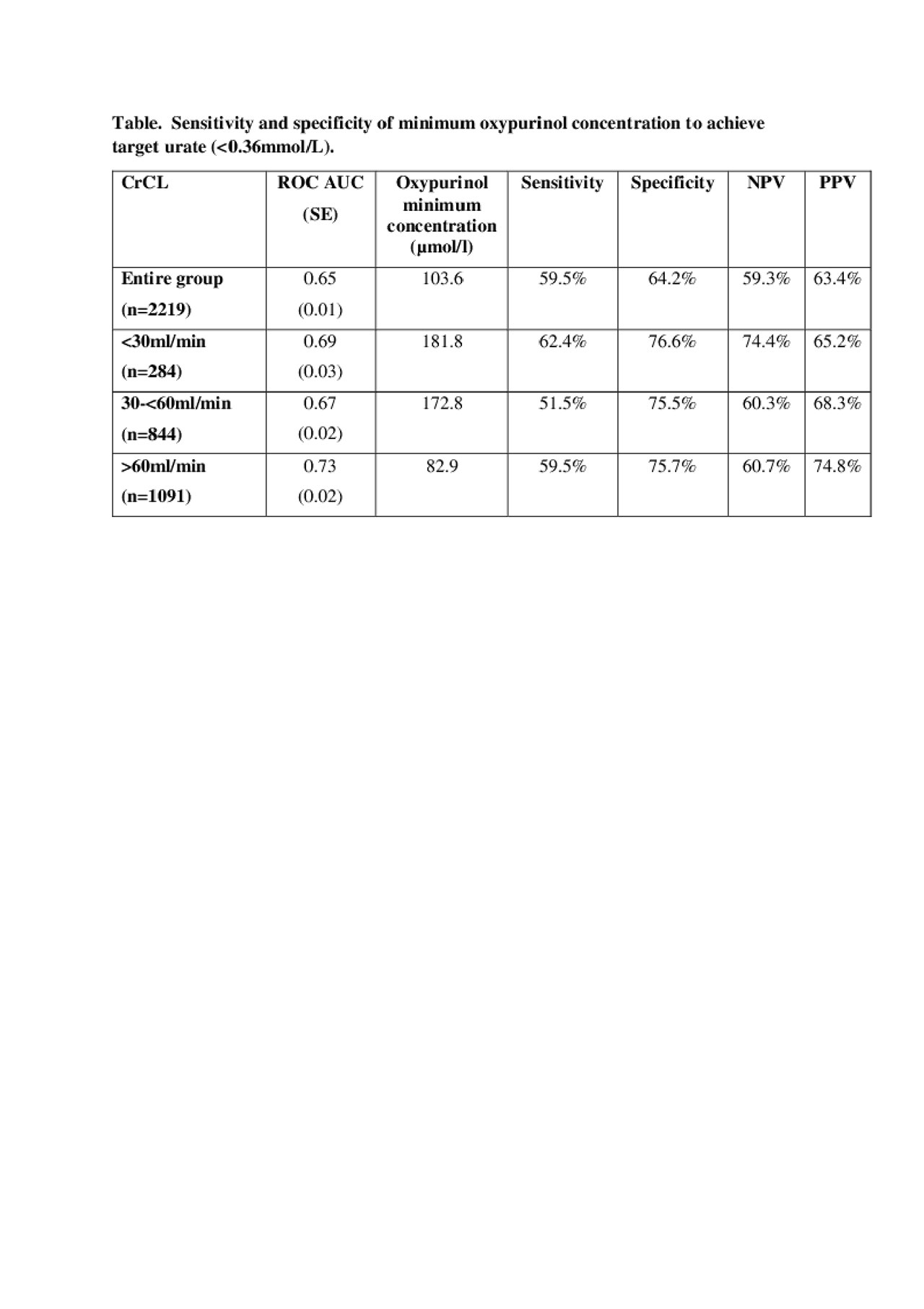Session Information
Date: Monday, November 11, 2019
Title: Metabolic & Crystal Arthropathies Poster II: Clinical Trials & Basic Science
Session Type: Poster Session (Monday)
Session Time: 9:00AM-11:00AM
Background/Purpose: Lack of a standardised allopurinol dose, with marked inter-individual variation in the dose required to achieve target urate contribute to failure to reach target serum urate levels. Given this variability in allopurinol responses, the ability of plasma oxypurinol levels to guide allopurinol dosing would be an advantage. Previous studies examining the relationship between oxypurinol and serum urate have been conflicting, with some showing no relationship and some an inverse relationship. Defining a therapeutic range has been challenging. The aim of this study was to determine the factors that influence the serum urate lowering response to allopurinol dose escalation and the conversion of allopurinol to oxypurinol, and to determine if there is a minimum therapeutic oxypurinol level.
Methods: Data from 129 participants in a 24-month open, randomized, controlled, parallel-group, comparative clinical trial were analysed. Allopurinol dose, serum urate and plasma oxypurinol concentrations were available at multiple time points. A slope for the association between allopurinol dose and serum urate was calculated for each individual as a measure of sensitivity to allopurinol. A slope for the association between allopurinol dose and plasma oxypurinol was calculated for each individual as a measure of allopurinol metabolism. Receiver operator characteristic (ROC) curves were used to identify oxypurinol concentration predictive of achieving serum urate < 6mg/dl.
Results: There were a wide range of serum urate concentrations for each allopurinol dose. Although there was a significant association between sensitivity to allopurinol (change in urate) and allopurinol metabolism (change in oxypurinol) for each 100mg increment in allopurinol dose (r=-0.60; p< 0.001), there was substantial variation between individuals (Figure 1 b and c).Body mass index (p=0.023), CrCL (p=0.037), ABCG2 Q141K (p=0.019), and baseline urate (p=0.004) were all associated with sensitivity to allopurinol, independent of other measured confounding variables. The oxypurinol ROC curve AUC to achieve serum urate < 6mg/dl was 0.65, with similar AUC values across all three CrCL groups (Table). The optimal minimum oxypurinol level for achieving target was strongly associated with CrCL (Table).
Conclusion: Although there is a relationship between change in oxypurinol and change in serum urate concentration, a minimum therapeutic oxypurinol is dependent on CrCL and cannot reliably predict serum urate target. Other variables, including ABCG2 Q141K genotype, impact on sensitivity to allopurinol.
To cite this abstract in AMA style:
Stamp L, Chapman P, Barclay M, Horne A, Frampton C, Merriman T, Wright D, Drake J, Dalbeth N. Relationships Between Allopurinol Dose, Oxypurinol Levels and Serum Urate – in Search of an Oxypurinol Therapeutic Concentration [abstract]. Arthritis Rheumatol. 2019; 71 (suppl 10). https://acrabstracts.org/abstract/relationships-between-allopurinol-dose-oxypurinol-levels-and-serum-urate-in-search-of-an-oxypurinol-therapeutic-concentration/. Accessed .« Back to 2019 ACR/ARP Annual Meeting
ACR Meeting Abstracts - https://acrabstracts.org/abstract/relationships-between-allopurinol-dose-oxypurinol-levels-and-serum-urate-in-search-of-an-oxypurinol-therapeutic-concentration/

